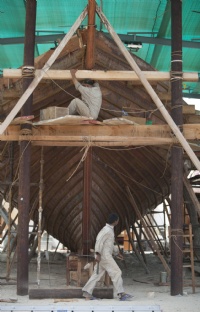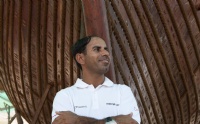
The Sultanate of Oman, at the Eastern tip of the Arabian Peninsula, is going through a renaissance of it’s maritime heritage. Taking it one step closer to their goal is the Jewel of Muscat project which is nearing completion. The importance of the relationship between modern Oman and its famed ancient seafaring traditions is of paramount importance as this oil rich Sultanate looks to diversifying it’s global perception as it becomes a modern country.
The Jewel of Muscat project is a joint initiative between Oman and Singapore involving the reconstruction of a 9th-century sewn-plank ship on the beach of Qantab village, just outside Muscat, Oman’s capital city. Once the 30-foot (18m) long hand-built hull is launched into the Gulf of Oman, she will set sail on an epic voyage that will finish in Singapore, one of Oman’s oldest trading p artners.
Displaying the characteristics of vessels built in the western Indian Ocean at that time, the Jewel of Muscat’s reconstruction represents a major feat of maritime engineering. Even today, the 1,200-year-old method of sewing the hull planks together with handmade coconut-fibre rope makes the vessel extremely resilient, and during the whole process – from shaping the first planks to hoisting the palm-leaf sails that were woven in Zanzibar – not one nail nor screw was used.
Jewel of Muscat takes its blueprint from a 9th-century wreck of a ship that was carrying more than 60,000 pieces of Chinese ceramics, silver and gold artifacts, spices and other commodities, now known as the Tang Treasure, that was discovered in 1998 in Indonesian waters. Jewel of Muscat will set sail from Muscat in early 2010 and travel along the same trade routes across the Indian Ocean as those described by Arab geographers and navigators. She is expected to arrive in Singapore in July 201 0 after stopping in India, Sri Lanka and Malaysia. Once in Singapore she will be officially handed over as a gift from the Government of Oman to the Singapore Government and housed in a museum along with the treasure from the original wreck.
The project began in Oman in Mid-June 2008 with the development of a model and the search for materials used on the original wreck, which were identified through scientific analysis. For the planking, Afzelia Africana was sourced from Ghana, for the beams teak from Burma was found and poona and teak from India were used for the mast and spars. The first plank was laid on 21st October 2008 and almost exactly one year later the Jewel of Muscat will slip into the sea where she will be rigged in readiness for her pre-voyage sea trials.
Saleh Said Al Jabri, formerly second in command of Oman’s tall-ship, Shabab Oman, and currently an instructor with Oman Sail, has been selected as Captain of Jewel of Muscat for her voyage to Singapore. “This project is of utmost importance to Oman and bringing our maritime history to life. I am honoured to be selected as the Captain of Jewel of Muscat and nothing will make me prouder than steering her along the old trading routes from Muscat to Singapore via India and Malaysia, just as our forefathers did before us.” Saleh brings a wealth of experience to his position through his experience of sailing on many of the world’s oceans and overseeing large crews in a wide range of conditions.
The story of the ship’s construction and voyage will be captured in two exclusive one-hour documentaries to be shown in 164 countries on the National Geographic Channel from early next year. The project website www.jewelofmuscat.tv offers a wealth of information on the project including short videos, photos, a 3D model of the ship, a timeline and a unique education section. There is also an archive section documenting the skills and techniques of sewn ship construction.

About Saleh Al Jabri
Title: Captain, Jewel of Muscat
Age: 39
From: Haramel, Oman
Background: Married with three sons and one daughter. In the Royal Oman Navy.
Hobbies: I have always loved everything to do with the sea since I was a child including swimming, sailing and snorkelling. I used to often compete in swimming races at the Naval base, but have never (yet) managed to win! The water is so crystal clear in Oman with beautiful coral and turtles; it is always great fun to go out snorkeling. I also enjoy camping, especially in the East of Oman around Ras al Hadd with the turtles for 2-3 days at a time.
Impressions of Jewel of Muscat: The Jewel of Muscat is a fantastic and inspiring project. It brings together the maritime heritage of Oman into the modern day and shows the people of Oman how hard their forefathers worked to make Oman into the great country it is today. It was a hard way of life back then and we should be thankful for what we have today.
To be part of this project, which will be a gift from His Majesty to the people of Singapore, gives me great pride, not only to sail on it but also to be the Captain. The education aspect of this project is also of paramount importance. Schools, academies, universities and colleges can all come to understand the ancient building methods using no nails or screws. We will also be utilizing on celestial navigation, the stars, the moon and the horizon and no digital aids!
What do you hope to achieve with the Jewel of Muscat project?: I hope to earn the trust endowed to me by handling the Jewel of Muscat safely and protect this gift from His Majesty all the way to Singapore. The people of Oman have entrusted me in this undertaking for them and I hope to help retain some of the things that helped make Oman great.
I also hope the spirit will carry on after this project has berthed in Singapore and is on display there. This should be a part of the big picture of Oman’s renaissance and the catalyst to Omani’s building and racing dhows. I also hope that it will mean the beach of Qantab will see more Omani craftsmen in the future working on building and racing traditional ships.
What do you think will be the hardest part of the journey?: Being patient will be one of the hardest parts. The wind will also be one of the toughest things to predict but this is the same whether you are on a 105′ long racing trimaran like Oman Sail’s Arabian 100 or a 1,200-year-old design like the Jewel of Muscat! Communication will also be difficult with an international crew, many of whom do not know each other, but this will be overcome quickly.
What will you do when the Jewel of Muscat project is over?: I will enjoy spending some time with my family after being apart for so long- that is the first thing I will do! In the long term I will be visiting educational establishments and anywhere else where I can talk about the importance of the project and do what I can to make sure that young Omanis come out sailing and encourage them to do something for their country’s benefit.
Sailing experiences to date:
– Sailing instructor for almost 20 years on board Shabab Oman.
– Competed in the Dubai-Muscat race for 5 times and won some podium places
– Competed in the Hobie 16 races in Oman and Dubai
– A Yacht Master from UKSA
– Joined the Round the Island Race 2008
– Crew member in The Arabian Extreme 40 Challenge
– Took part in the Tall Ship Races when Shabab Oman won the Friendship Trophy in Europe, America, Australia and Asia.
Ambition: I almost got around the world on Shabab Oman, but never managed to get to South America – I would love to manage to do the whole thing! I would also like to teach Omani children about our maritime heritage in Oman. I would be really happy to open a sailing club and give others the opportunity that I have had.